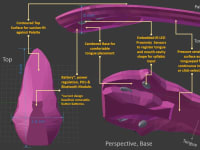MouthSpace is an input device for mobile and assistive computing. It replaces the Mouse and the Keyboard when convenience, mobility or security constraints prevent their use.
Other input methods cannot match the Keyboard-and-Mouse combination for accuracy, speed or potential for productivity, because hand motor control is difficult to replicate for discrete-input actions (typing) or continuous-input actions (mouse movements). Speech recognition has intrinsic problems—decomposing acoustic waves into syllables is computationally intensive, heuristic, and prone to error.
The human tongue, however, performs hand-like actuation, repetitively, without sacrificing speed.
MouthSpace is a simple pressure sensitive pad with an array of embedded LED proximity sensors. The contoured shape of the pad fits comfortably within a user’s mouth, and sits against the palette, like a partial upper denture.
For continuous-input actions, our tongues are capable of fine, force-calibrable motion against our palates, as intuitively as swiping a touchscreen. MouthSpace offers a pressure sensitive surface for the tongue to draw on, replicating mouse-like motions.
For discrete input, MouthSpace takes advantage of the fact that each time we form a syllable, the shape of our mouth-cavity, and its proximity to the tip and dorsal parts of our tongue, is distinct and parametrically characterizable*. MouthSpace’s array of proximity sensors registers syllables based on the distance to different parts of the tongue and mouth cavity. Syllables can be recognized and transcribed as fast as the user can form them. A distinctive tongue-curl (naturally induced when the tongue-tip touches the palette) differentiates between syllabic-input and touchpad-input.
Since vocalization is not required, MouthSpace offers greater security than voice-commands or typing, especially in public spaces. The user’s dictation remains private, and nobody can look over the user’s shoulder to see keystrokes.
MouthSpace’s heat-molded nylon pad is composed of ultra-thin layers: an array of conductive elements, neoprene isolators, circuit elements, and nylon outer layers. A cambered cross-section allows the integration of three microchips, a Bluetooth antenna, and a small battery pack near the front of the mouth-cavity, where the gap between palette and tongue is greatest.
MouthSpace is sized to feel like a sports mouth-guard, without over-tooth protrusions. Suction and two clips keep MouthSpace firmly attached to the palette. The lack of over-tooth elements makes molding or customization unnecessary. The nylon construction is bacteria and corrosion resistant, and easily cleanable.
All components and materials are available off-the-shelf. The manufacturing process requires nylon-substrate PCB printing and heat-molding, heat-curing facilities, as well as firmware improvement. Commercial unit price (large batch) is targeted at $150 – 200 USD, single-order prototype cost is $1400. Users need a Bluetooth-capable smartphone, tablet or computer to pair with the device.
With the ubiquity of smartphones, and with novel devices like Google Glass looming on the horizon, users need error-free input hardware to boost productivity. MouthSpace also offers a lot of potential as an assistive technology to improve the quality of life and computing experience for differently abled users.
* Yunusova Y et. al. “Positional targets for lingual consonants defined using electromagnetic articulography”. J Acoust Soc Am. 2012 Aug;132(2):1027-38. doi: 10.1121/1.4733542.
Like this entry?
-
About the Entrant
- Name:Thomas Meyer
- Type of entry:individual
- Software used for this entry:MATLAB, CATIA, EXCEL, Blender for non-technical 3D drawing, Project Requirements tracking via database
- Patent status:none








